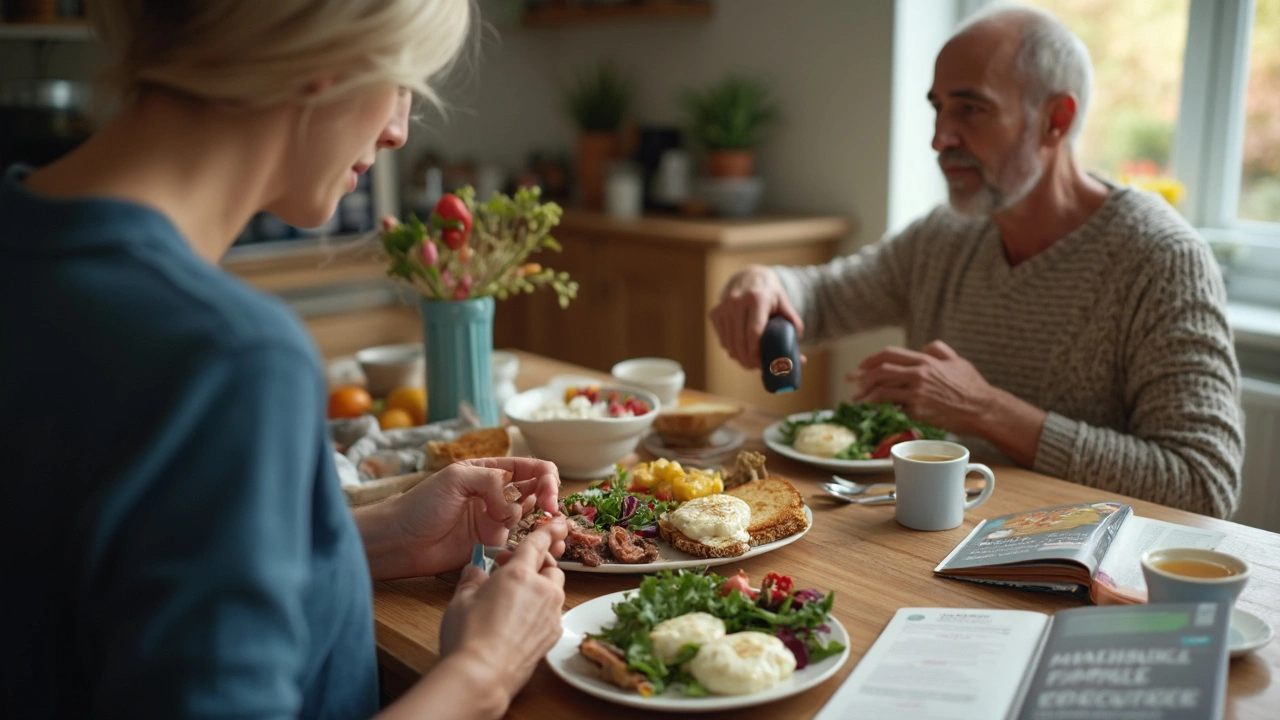Why Balancing Blood Sugar and INR Feels Like Juggling Flaming Torches
Ever tried following two sets of rules at once, knowing if you slip, things could get messy? Welcome to the world of warfarin and diabetes. One medication is obsessed with your vitamin K intake (hello, leafy greens!), while diabetes wants you to time meals and check blood sugar like clockwork. Both conditions have their own food lists, timing rituals, and finger-pricking routines. No surprise, it’s easy to get overwhelmed.
Here’s a bit of context—the “INR” is the number your doctor stares at to see how thick or thin your blood is. If you’re on warfarin, that number matters a lot, because too much can mean a higher risk of bleeding, and too little…well, you’re risking a clot. Diabetes, on the other hand, watches your blood sugar like a suspicious cat, and it does not like surprises after meals or snacks. The eating patterns that keep INR stable often clash with the ideal diabetes meal plan. Add in vitamin K chatter and it’s enough to make anyone want to throw in the towel and order pizza (which, by the way, is rarely safe for either condition!).
The American Diabetes Association and plenty of studies warn about unexpected INR swings when folks with diabetes change their habits—like adding a new veggie, skipping breakfast, or trying out the latest salad craze. Plus, 1 in 10 people with diabetes over age 60 take some form of anticoagulant, which means this is not just a rare issue. Every change, even a small one, can cause big shifts if you aren’t paying attention. So, how do real people (not just nutritionists) make this work?
How to Design Meals for Dual Management
Instead of two meal plans taped to your fridge, think of your plate as a peace treaty between blood sugar management and INR control. Both diabetes and warfarin need routine, so your stomach clock needs to be set to “predictable.” Eating at the same times every day helps, but it’s more than just the clock. The balance between carbs, proteins, fats, and vitamin K is the secret sauce.
- Carbohydrate consistency: If your blood sugar loves patterns, don't shock it with a coffee-and-muffin breakfast one day and a full brunch the next. Clusters of 30–45 grams of carbs per meal, at regular intervals, work for most adults. This keeps blood sugar from spiking or plunging, which can, by the way, alter your INR.
- Vitamin K awareness: Greens are not your enemy, despite what your warfarin pharmacist warned. The real danger is being unpredictable with your vitamin K intake. You can eat spinach or kale—just do it consistently. A sudden, heroic salad can make INR drop like my dog Rupert chasing a squirrel.
- Pairing protein and healthy fat: These slow down glucose absorption, maintaining steady blood sugar. Think grilled chicken, beans, or salmon with olive oil, and keep your carbs in check.
- Watch the hidden K: Broccoli, Brussels sprouts, and even some supplements pack vitamin K. Check labels! And fun fact: kiwifruit and blueberries are on the safe low-K list, so snack away.
- Track everything: A food diary really helps when you’re troubleshooting a surprise INR swing. Plus, reviewing what you ate lets your care team spot patterns you might miss.
There’s a handy chart most registered dietitians love, ranking foods by vitamin K content per serving. Don’t be afraid to ask your clinic for one or print your own. Suddenly, you’ll look at a Caesar salad and know if it’s your friend or foe.
| Food | Serving Size | Vitamin K (mcg) |
|---|---|---|
| Cooked Spinach | 1/2 cup | 444 |
| Broccoli | 1/2 cup | 110 |
| Lettuce (Iceberg) | 1 cup | 17 |
| Kiwi | 1 medium | 40 |
| Peas (frozen, cooked) | 1/2 cup | 19 |
| Egg (boiled) | 1 large | 0.3 |
Meal planning is a daily experiment, but if you repeat what works, you’ll know when something is off. Your blood sugar and INR will thank you.
The Right Way to Time Glucometer Checks with Warfarin
Finger pricks aren’t anyone’s favorite hobby, but they’re important—especially if you’re balancing blood sugar and INR. It’s not just about how often you check, but when. Here’s what most endocrinologists and anticoagulation clinics recommend (assuming your doc hasn’t given you different instructions):
- Check fasting blood sugar right after you wake up. This gives a clean snapshot of your overnight control and helps predict how your INR will behave the next day.
- Before meals—especially breakfast, if you use insulin or sulfonylureas. Knowing your pre-meal number helps spot patterns.
- Two hours after meals is key. That’s when blood sugar spikes, and it’s also when new foods can interact with warfarin’s effect.
- Whenever you feel “off”—having a funny feeling a meal hit differently, or taking a new medication? Check!
Why does the timing matter so much? Big blood sugar swings can actually make your INR harder to control. Medical journals have found that quick drops or unexpected rises (like the spike after a surprise birthday cupcake) can thin or thicken your blood unpredictably for 24 to 48 hours. Ever notice your INR climbed higher after a day-long sugar slump? It’s not a coincidence.
Medication changes matter, too. If your diabetes meds are adjusted, your warfarin dose may need a closer look. Real life example: my neighbor with type 2 diabetes upped his metformin after his A1C crept up. His INR dipped like Tabitha dodging a thunderstorm. It took two weeks and some serious meal log detective work to bring things back in line.
One last thing—if your glucometer is a relic from 2007, time for an upgrade. Today's meters track, graph, and even warn you about patterns. Think of it as the Fitbit for your blood sugar.

Vitamin K: Friend, Foe, or Frenemy?
Vitamin K gets a bad reputation in the warfarin crowd, but the truth is more complicated. It isn’t about avoiding green vegetables forever, but staying steady. Throwing your body a curveball with a sudden kale smoothie can throw INR for a loop, but a small, daily salad won’t—if you keep it up. The trick is not the amount, but the consistency.
So what counts as a “safe” daily vitamin K intake? Most clinics say about 90–120 micrograms for adults. Some people will have higher or lower targets, depending on their INR goals and genetics. The key is not eating a giant salad once a week, but smaller servings daily. That keeps your warfarin dose from needing constant tweaks.
Here’s where it gets interesting: some diabetes “superfoods”—like broccoli, kale, and spinach—are also high in vitamin K. The immediate thought is: “So am I doomed to plain chicken and white bread?” Actually, no. People in multiple long-term studies who found a steady, moderate vitamin K routine—say, a half-cup of cooked spinach every other day—enjoyed steadier INR and felt better energy to handle their blood sugar swings. It’s not a zero-sum game. You can have your greens if you plan your routine around them.
Want more fun with “hidden K”? Oils—like soybean and canola—have vitamin K. So does seaweed, herbal teas, and even green smoothie powders. If you shop at lots of different grocery stores, keep in mind one bag of spinach isn’t always the same as another. That’s why writing down what you eat, at least for a few weeks, can help spot patterns. Your INR isn’t shy; it’ll tell you if something’s changed.
Supplements deserve a mention. Multivitamins sometimes pack vitamin K (especially the “for bone health” kind), so read those tiny ingredient lists. And remember, antibiotics, some heart meds, and even herbal teas can shake things up. Always loop your doctor or pharmacist into these changes; they’ve literally seen it all.
How to Handle Real-Life Changes without Panic
Change is inevitable—new jobs, travel, holidays filled with mystery casseroles. If you’re proactive, you can bend without breaking your control over INR control and blood sugar. Here’s what works for actual humans, not just what’s printed on a handout.
- Expect surprises, don’t fear them. If you know you have a family gathering (and Aunt Marge’s famous green bean casserole), check your blood sugar before and after meals, and add an extra INR check a day or two later.
- Travel tips: Pack your medications in carry-ons, bring pre-portioned snacks, and double-check time zone shifts—your blood sugar doesn’t reset itself when you land. Set alarms for reminders to test and eat if you’re jet-lagged or busy.
- Dining out: Read the menu online in advance. Steer towards proteins and lower-carb sides. If you’re stuck, order a side salad (ask for the dressing on the side) and eat around the vitamin K heavy hitters—no shame in picking out the spinach.
- Social events: Bring your own snack. Don’t assume you’ll find a good fit at a buffet. Quietly munching a baggie of almonds is better than fixing a post-event blood sugar or INR mess.
- Doctor communication: Keep your care team in the loop about any frequent INR changes or big blood sugar swings. Warfarin doses might need tweaks, or new meds could interact unexpectedly.
- Phone apps: Use apps or medication trackers to create routines. Some apps link directly to pharmacy records or INR labs. The less you have to remember, the more you can do with your day.
Real talk: There might be a week or two where you and your warfarin go into battle with your favorite sandwich or birthday cake. Forgive yourself—what matters most is spotting the pattern and getting back to your routine. The goal isn’t perfection, but fewer surprises each month.
For more tips on managing warfarin with diabetes, check detailed guides by doctors and patients like you, who’ve done the balancing act for years and know the reality beyond textbook tips.
Staying Ahead: Support, Habits, and What Really Works
Managing both warfarin and diabetes doesn’t mean becoming a full-time nutrition detective or never eating out again. Real life is busy—work, family, chasing pets, whatever else life throws at you. Here’s what people say makes the biggest difference once you’ve got the basics down:
- Establishing routines: Same breakfast, similar lunch, and set meal times simplify decisions. When Rupert (my Bernese Mountain Dog) noses me awake every morning at 7:00, I use it as my cue to check my blood sugar and have breakfast—same oatmeal most days, so I can spot changes faster.
- Social support: Don’t go it alone. Family, friends, online support groups, or even your pharmacy’s texting service can remind you or hold you accountable. People with reliable support networks are 30% less likely to miss critical medication doses or meal checks, according to recent studies.
- Pets and routines: Seriously! Walking your dog at the same times each day (and fighting the cat off your cheese sticks—looking at you, Tabitha) is underrated for keeping you on track.
- Ask for help: If meal planning or cooking overwhelms you, consider meal kits or prepping meals in advance on your low-energy days. Ask a dietitian to review your routine—they catch things you might’ve missed.
- Be flexible but attentive: If you see a pattern of rising blood sugar or dipping INR, respond calmly and reach out to your care team. Tweaks to your warfarin dose, or your meal timing, can make a fast difference.
Building habits—and forgiving yourself when things don’t go perfectly—is more sustainable than chasing perfect numbers every day. Stay curious, stay consistent, and don’t be afraid to laugh at the chaos now and then.
